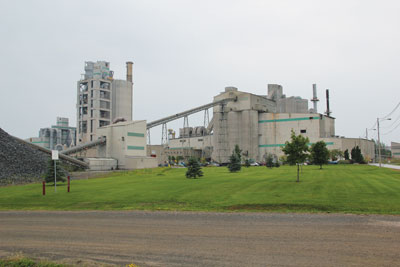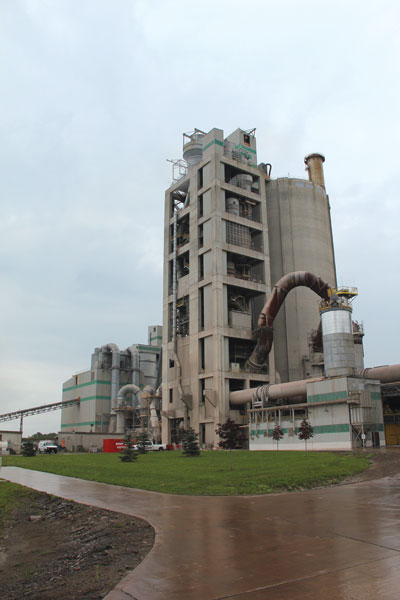
Features
Aggregates
Technology
Rock Stars
St Marys Cement in Bowmanville, Ont., has achieved substantial savings through improved energy manag
October 11, 2012 By John Tenpenny
E=MC2 may cause people to scratch their heads as to its meaning
E=MC2 may cause people to scratch their heads as to its meaning, but when a group of employees at St Marys Cement plant in Bowmanville, Ont., created an integrated energy management team in 2006 to look for ways to reduce the operation’s energy consumption, Einstein’s formula made perfect sense: Energy Management Conservation Committee.
 |
|
| A key component of the energy initiative at St Marys is employee awareness and training that includes an annual Energy Conservation Week.
|
St Marys Cement Inc. is a leading manufacturer of cement and related construction products in Canada and the United States. The company operates two cement plants in Ontario – one in St. Marys, where the company was founded in 1912, and one in Bowmanville. The company is now part of Grupo Votorantim, a diversified Brazilian conglomerate with operations that include cement, pulp and paper, aluminum and metals.
The Bowmanville plant manufactures cement and other cementitious materials for organizations in the Great Lakes region. It employs 150 people and operates 365 days a year around the clock. According to plant operations manager Fabio Garcia, energy is up to 40% of its operating cost and, for a facility that was built in 1968 (retrofitted in 1990), a commitment to reduce energy costs and energy waste in order to protect both the bottom line and the environment was crucial.
“To compete with other plants we had to be more efficient,” he says. “But every time you’re saving energy, you’re reducing emissions as well and that’s a more compelling reason than just saving money.”
The multidisciplinary committee was started by Garcia and electrical maintenance manager Jim Storey. They assembled a cross-functional team with representation from production, quarrying, processing, electrical maintenance and other departments to ensure all affected business units had input into the committee’s mandate, direction and activities.
The team made a number of strategic suggestions, including the development of a “performance scorecard” used to assess the plant’s energy performance in five key areas: energy data management, energy supply management, energy use in facilities, equipment efficiency and organizational integration.
With the support of management, the committee also developed a Sustainable Energy Plan to identify energy management activities, to provide a mechanism to communicate the status of these activities to key stakeholders, to capture tracking and measurement efforts, and to guide the company’s energy efficiency priorities and investments.
Energy Excellence Program
It’s this broad and all-encompassing approach to energy management that earned St Marys its Silver Certification in Energy Excellence (CEE) in 2009 from 360 Energy Inc., a Ancaster-based energy services firm.
 |
|
| The Certification in Energy Excellence program that the St Marys plant underwent involved a 12-month assessment of over 160 areas. |
“[St Marys] had done some energy projects, but they recognized that if they didn’t keep the momentum going, they might run out of steam,” says David Arkell, president and CEO of 360 Energy. Proving to skeptics the accuracy and veracity of the energy savings was also important.
The CEE program involved an in-depth, 12-month assessment by independent energy professionals being given access to over 160 areas of the plant to evaluate equipment and procedures. “[The] program’s goal is to encourage a progressive energy management activity where you can measure and verify the savings,” says Arkell. “What’s unique about this program is its comprehensive approach – it doesn’t just look at energy efficiency.”
To participate in the process, companies have to have at least three years of ongoing energy management activity with demonstrable action and energy savings and they also need to have an infrastructure and a plan in place to continue with energy performance activity for the next three years.
“This was exactly what we needed – a process that used outside energy experts who could assess and confirm our past activity, but also provide mentoring on how we could continue our ongoing energy performance improvements,” says Garcia.
Since 2006, St Marys has reduced electrical consumption by over 9.4 million kilowatt hours and avoided energy costs worth over $2 million. Intensifying its efforts, the plant saved $1 million alone in 2011 and expected to save at least that in 2012.
One of the biggest areas of savings – and a source of revenue – came from electricity usage and St Marys’ work with the Ontario Power Authority’s Demand Response (DR) 1 Program. Tapping into that revenue was one of the priorities on the E=MC2’s 68-item action list to direct the plant’s efforts to reduce its energy and consumption and costs.
Already, those activities have delivered $550,000 in savings and $258,000 in energy rebates. “Some of the lowest cost projects yielded the biggest paybacks,” Garcia says. “The single most important change we made was rescheduling some of our operations to off-peak hours.” This concept, known as load shifting, has saved the company hundreds of thousands of dollars.
“We’re glued to the IESO website,” Garcia continues. “We’re constantly monitoring the wholesale price of electricity to plan our operations. And while it’s not the easiest way to manage a plant, it’s definitely the most economical.”
While the kiln at the heart of St Marys’ cement production must run continuously and cannot be shut down, other energy-intensive processes were easily shifted to off-peak hours, including milling, grinding, material handling, fuel unloading, and conveying.
In addition to using the price of electricity to guide daily operations at the Bowmanville plant, control room operators also rely on alarms set to go off if the plant approaches pre-determined demand thresholds. By lowering its instantaneous demand for electricity by 500 kilowatts (kW), St Marys has been able to trim almost $2,000 from its monthly electricity bill.
Some of the other easy fixes implemented at the plant include adding monitoring and control software, retrofitting light fixtures in the office and production areas, installing occupancy sensors in the office space, raising the thermostat setpoint for baghouse fans used in dust control, and automating processes to shut down equipment when inactive.
Each area of the plant is now monitored individually for its electricity usage, with instantaneous values and targets displayed in the main control room. After careful evaluation of the potential impacts, operators made a bold and daring suggestion – the elimination of one of two 1,500 hp fans powering the bypass system. Although both fans are still available, only one is in service at any given time, leaving the second fan available for back-up when maintenance is required. This process improvement alone saved the company $96,213 in 2007.
In addition to focusing on process and equipment improvements, the plant turned its attention to financial incentives available for energy efficiency projects. By tapping the Electricity Retrofit Incentive Program (ERIP) and Sustainable Technology Development Canada (STDC), St Marys secured funding from external sources.
The plant also recently shifted to OPA’s DR 3 program, a lucrative demand response program with contractual obligations to shed power demand at peak times. The program pays participants for turning down their electricity by a specified amount when Ontario’s electricity system reaches certain pre-established targets – in St Marys case, five days, or activation periods of their choosing. According to Garcia, their years of energy management have given them more sophisticated knowledge, which was proven when they reduced the number of times it took for them to predict their five days from 20 down to eight.
ISO 50001
Another milestone was reached earlier this year when the Bowmanville plant was the first in Canada to achieve ISO 50001 Energy Management Systems Standard certification, something Garcia says was a direct result of the energy initiatives undertaken since 2005.
In 2009, OHSAS 18001 (Occupational Health and Safety Management Systems) certification was added to the ISO 9001 and ISO 14001 certification; the same year, the plant received its CEE designation. Jason Schulz, the plant’s quality manager, explains that the CEE and ISO 50001 certifications go hand-in-hand. “ISO 50001 provides the framework for a strong energy management system, while CEE ensures that the energy gains are validated.”
Over the years, the plant has been recognized for its efforts through various awards, including the Canadian Industry Program for Energy Conservation’s (CIPEC’s) Leadership Award and the Portland Cement Association’s Energy and Environmental Awards. It was also named among the top 10 companies making a difference in Natural Resources Canada’s 2008 CIPEC annual report.
A key component of the company’s energy initiative is employee awareness and training. Garcia adds that real-time energy data displays are accessible throughout the plant to inform employees about energy use. These displays and targeted employee training underline a behavioural change that Garcia and his colleagues are hoping to see. “We want to enable our employees to make energy management decisions at work and at home.”
They brand all related material with the E=MC2 logo, publishing newsletter articles about conservation issues, providing training to new and existing employees, participating in Earth Hour, displaying the plant’s awards for energy and environmental achievement, and scheduling an annual Energy Conservation Week at which employees learn about energy management at home and in the workplace. This year’s event included seminars on fuel efficiency, hydrogen/power generation from waste heat and addressing fuel efficiency challenges, as well as an awards ceremony to celebrate the past seven years of conservation efforts that led to the certification.
It’s a process that never ends. Currently, the St Marys Bowmanville plant is working towards its recertification under the CEE program.
“Recertification requires a demonstration of continuous improvement over three years,” Garcia says. “We’re always re-evaluating what we do and how we do it, and we look forward to seeing what sort of improvements we can make in the next couple of years.”
Print this page